 By Staff By Staff
May 25, 2016
BURLINGTON, ON
Symphony on the Bay: The Orchestra for Kids.
May 28 11:00 AM
Admission is $10 + HST for children (one free chaperone per child).
This program was sold out last year so buy your tickets early to avoid disappointment.
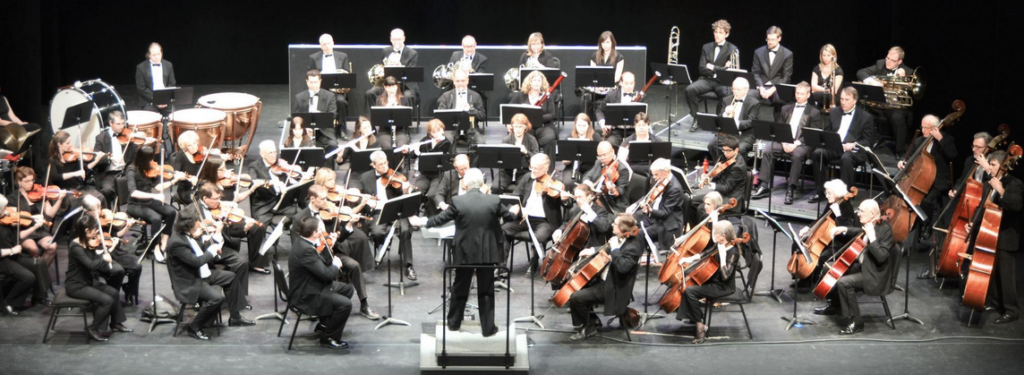 All this – for $10 
 By Staff By Staff
May 23rd, 2016
BURLINGTON, ON
 Tamara Kwapich – self portrait
Teresa Seaton has invited her friends to see Tamara Kwapich’s ” Feathers Fur and Fables” Exhibiton on Sun June 5th form 1pm – 4pm. She will tell you it is a great way to spend a Sunday afternoon.
Kwapich was one of six artists whose work was placed in the city – one in each ward. We will tell you more about her when her event takes place
What we can tell you wish much certainty is that you want to get to the gallery before May 29th – when the
 Michele Van Maurik peonies at the Seaton gallery. Michele VanMaurik exhibiton comes to an end on May 29th. If you haven’t had a chance to see her flowers you are really missing something.

 By Pepper Parr By Pepper Parr
May 19th, 2106
BURLINGTON, ON
Introducing new technology into a retail operation with a very strong brand has to be managed very very carefully. There can be no glitches.
McDonalds took a bold step and put in large screens at which people could place their food orders – the device covers all the bases and accommodates just about every need you can imagine.
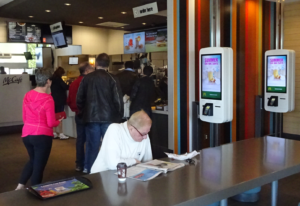 Some people prefer the smile that comes with the service from a person behind the counter. But at some locations – the devices don’t get used. “There are people who would rather talk to the person behind the counter” explained Ryan Sgro who has the ability to hold a conversation and at the same time constantly scan the service counters.
“Each McDonalds has its own environment – some get more traffic at the drive through – others have line ups that lead out the door” added Sgro.
The McDonalds on Plains Road and King Road intersection in Aldershot is one of those place people drop into – quite often a group of people getting together to have a cup of coffee. The windows on the western side draw those who want to read a newspaper in the sunshine.
For those who decide to use the screens – they are actually fun.
You sort of talk to the screen by just touching it.
 Eating in or taking it home?  I wanted an Angus burger and the options available to me were right in front of me – all I had to do was touch the screen.  I could tune up the taste as well – give it a little zip. 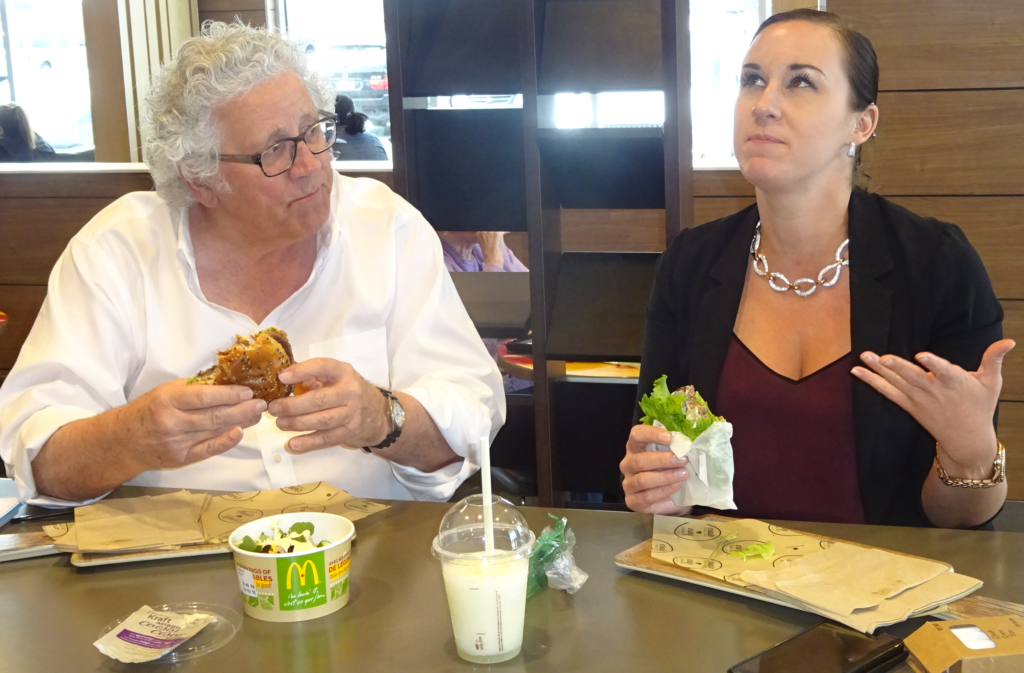 The result of the Angus Burger I created can be seen by the smile on my face. My friend was just as pleased with her salad The Sgro family operate six franchises in Burlington and one in Waterdown. Ralph, who started out with the McDonalds corporation a long time ago as an employee where he once worked at the Guelph Line location, drops by and remind son Ryan of a task and then nods to a customer who has been coming to the Plains Road location for years.
There are a lot of young people in Burlington who got their first job at McDonalds, said Ralph. “I’m pretty certain that we trained a lot of the people who now work at Canadian Tire because when I go in there to make a purchase I see a lot of my former staff working there” he added.
Ralph talks about the value of community for his locations. “There was once a serious fire at Walkers Line and Upper Middle Road – we made up meals for the firemen (and women) who had to battle that blaze – we ended up feeding some of the people who had to flee their homes.” Ralph explains: “We had a kitchen and food – they were hungry – we fed them.”
Ryan comments on the view some people have that the technology is taking jobs away from people.
“Nothing could be further from the truth” explains Ryan. The technology allows us to handle food orders faster which means more volume which means needing more people in the kitchen.”
Also, people can take their time in front of the screen and they usually aren’t holding anyone up – there are two of the large screens in each location. Once you get the hang of the things they are pretty easy to handle.
 The burger I created was so good – they named it after me. But the Sgro family nixed that idea – they did let me have the picture. McDonalds calls the technology – “Create your taste”.
It worked for me.

 By Staff By Staff
May 18th, 2016
BURLINGTON, ON
The City of Burlington public art program is inviting professional artists and artist teams to submit expressions of interest for an Artist-in-Residence program.
Working with the city’s Arts and Culture staff, the selected artist(s) will conduct a 6-month residency to research the existence of ‘cultural nodes’ in Burlington.
In addition to attending planning meetings and consulting with key stakeholders, the selected artist will create temporary public art interventions to engage and interact with the community.
This is a non-live-in residency however the selected artist is expected to visit Burlington frequently and must live within easy travel distance.
The city’s public art program, funded for the most part from Planning Act Section 37 funds (these are monies developers give the city for additional height and density among other things). The city puts $50,000 of its own money into the public art plan.
The opportunity is made up of a $10,800 artist fee and up to $10,000 materials
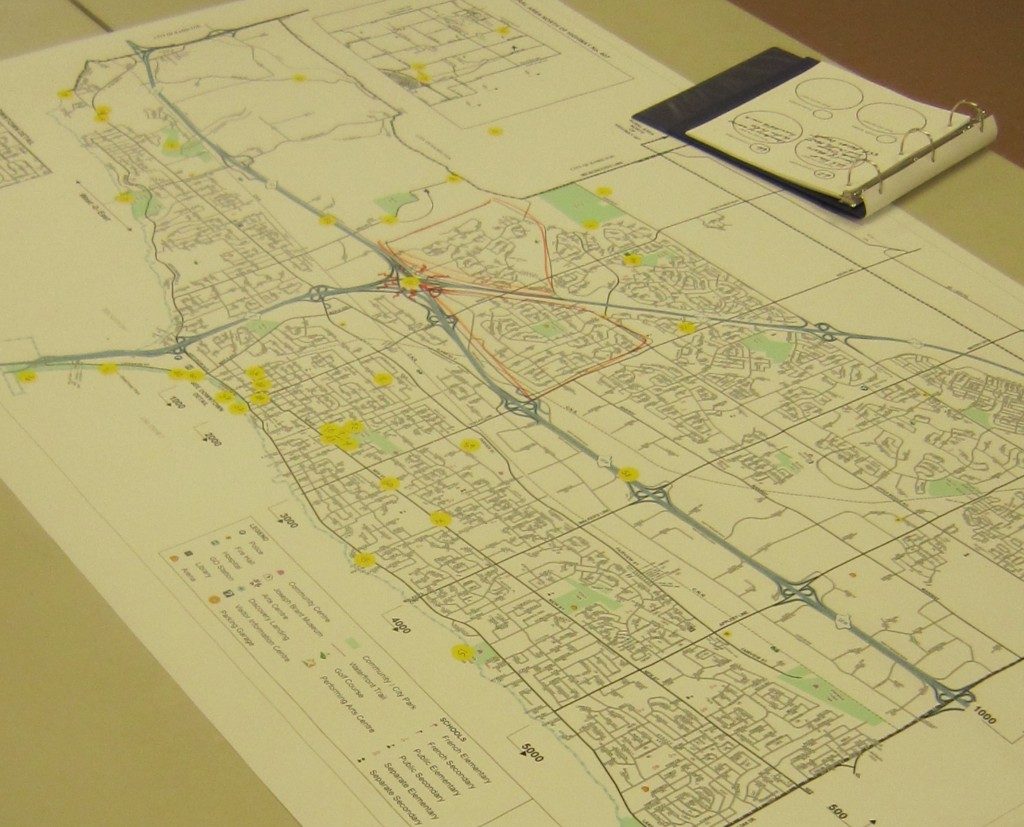 Early in the creation of the Cultural Action Plan people were asked to indicate where they saw culture taking place in th city. The next step is to build on the knowledge gathered. The city has a Cultural Action Plan as well as a Culture manager and of course there is the robust arts collective that leans on city council every opportunity it gets.
Burlington hired Hamilton resident Jeremy Freiburger to craft the Cultural Action Plan. The work leading up to that document included asking people to map out where they “do” culture and how they define culture. Links below on those new stories as well.
The focus appears to be looking for ways to better define cultural nods. We are not sure that research actually makes that kind of thing happen – when people find a place they want to be they gather at that place and it just becomes a node. The approach this call is using sounds and feels a little like “social engineering” – and we know where that kind of effort gets us.
The project goals include:
The integration of an artist’s perspective into planning cultural nodes
Create opportunities for street-level cultural engagement through unique public engagement activities and temporary public art installations
Make recommendations on ways to link identified cultural nodes
Make recommendations on future permanent public art installation(s) related to cultural nodes
The deadline for this opportunity is Monday, June 20, 4:00 p.m. Artists wishing to learn more about this project are invited to an optional information session on Wednesday, June 1 (7:00 to 8:00 p.m.). The presentation will be followed by an open Q&A session with the public art manager.
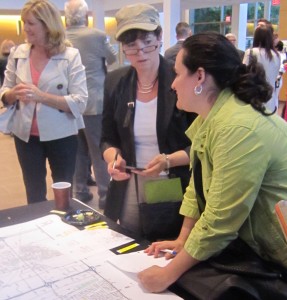 From the left – three people heavily involved in the cultural community: Deb Tymstra, Teresa Seaton and Donna Grandin. Artists interested in learning more about this project are invited to an optional information session at the Halton Hive, 901 Guelph Line, Burlington. Loads of parking. The Hive is just south of Harvester Road . A brief presentation will be followed by an open Q&A with the public art manager.
Those wishing to attend must RSVP by Monday May 30th at https://www.eventbrite.com/e/artist-in-residence-information-session-tickets-25377297179?aff=mcivte
For more information contact:
Kim Selman, the Public Art Manager over at Cobalt Connexts is the lead on this. You can reach her at
kim@cobaltconnects.ca or at 905-548-0111

 By Staff By Staff
May 19th, 2016
BURLINGTON, ON
Tansley Woods pool is closed for the remainder of the day due to an unforseen maintenance issue. The pool is expected to reopen at 6:00 a.m. on Friday May 20, 2016
The following programs are cancelled:
• Combo Lap Swim 10:30am-noon
• Lap Swim Noon – 1:30 p.m.
• Water Running 1:30-2:30 p.m.
• Swimming lessons 5 to 8:30 p.m. Information on make up options will be distributed at next week’s lesson.
• Aqua Boot Camp at 7:35 p.m.
• Leisure Swim 7:30-9:00 p.m.
• Swim Training 8:30 to 9:30 p.m.
The Aldershot pool closing announcement used the same wording – they were close for several days.
They rarely say what they mean by an unforeseen maintenance issue.

 By Pepper Parr By Pepper Parr
May 19th, 2016
BURLINGTON, ON
Have you herd of the Eddies?
The 15th annual Eddies Gala Awards evening – a popular festival celebrating student filmmaking – will be held on Tuesday, May 31, 2016 at the Burlington Performing Arts Centre.
The theatre doors open at 6:30 p.m. and the awards celebration begins at 7 p.m., followed by screenings of this year’s winners. This event is open to the public, no tickets are required and admission is free.
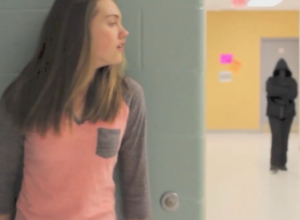 A clip from an Eddie winning entry. The Eddies, the Halton Student Film Festival, celebrates student success in filmmaking by recognizing technical and creative achievements and is open to all elementary and secondary students. Previous Eddies award winners have gone on to achieve success in the film and television industry, with some capturing prestigious awards for their work.
This year the event is highlighted by an impressive list of professionals who will judge the submissions. They include:
• Mandy Holyoke – Production Coordinator for Little Charmers, a popular Nickelodeon animated series.
• Kyla Springall – Assistant Production Manager at Cineflix, has been Production Coordinator on Property Virgins for 84 episodes and is now coordinating a Property Virgins spin-off series.
• Vaishni Majoomdar – experience includes casting on Good Witch, Reign and Schitt’s Creek.
• Omar Salama – Creative Director at Block 94.
• Jeff Bowman – retired Multimedia Administrator and co-founder of The Eddies.
• Ana Yavari – Editor on The Tudors, The Borgias and the Showtime series Penny Dreadful.
“Approximately 500 students participated this year from various subject areas making this a true display of how technology can be integrated in all academic and technical subjects,” says Dale Andrews, teacher at White Oaks Secondary School and co-organizer of The Eddies.
For a look at one of the entries that won last year CLICK here

 By Pepper Parr By Pepper Parr
May 18th, 2016
BURLINGTON, ON
The question was – what will she have to show us when the Performance Arts Centre reveal takes place? Will it compare favourably with the superb program Brian McCurdy delivered before he took leave of running the Centre?
And would there be room for the local talent – and not just shows that were travelling and could spend an evening in Burlington?
And is the lineup for 2026/2017 a good line up?
 Performing Arts Centre president Suzanne Haines chatting with a patron after the presentation. Suzanne Haines delivered.
It’s a more than decent line up – and if the VIP members who lined up to buy tickets are any indication – the year will keep city council happy, meaning that BPAC won’t be back asking for more money – they already get close to a million dollars as it is.
A VIP member is a patron who has purchased 4 or more shows in the previous season and the capital donors and supporters.
There are a couple of boffo stand outs to comment on. The Shanghai Acrobats from China are astounding – a cultural circus if you will.
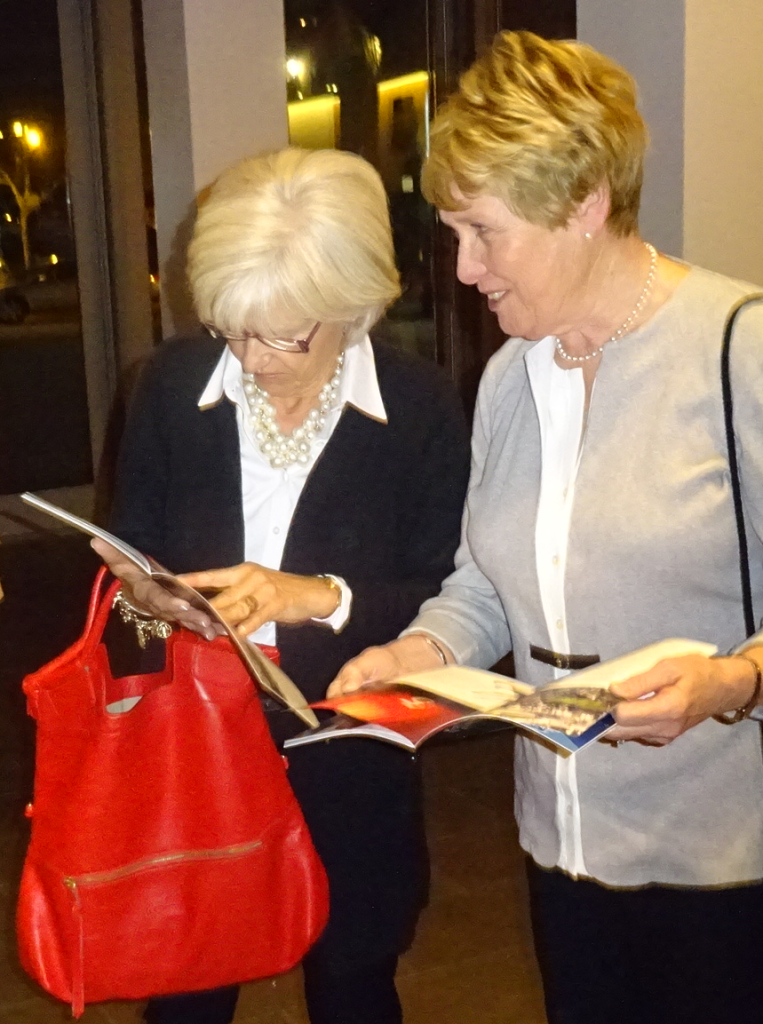 Two Performing Arts Centre patrons flipping through the program book. The Aga Boom – three clowns that will delight both parents and the children they bring with them. The pricing on this one is great $15 if you bought a series.
Series pricing is $5 off the regular price if you buy tickets to four or more events. If this show doesn’t sell out – turn the Performing Arts centre into a day care centre.
A lot more jazz than one might have expected – most of it top rank
A solid family program for the Christmas season.
Some greats – Les Grand Ballet out of Montreal, the Nylons Farewell tour, Piaff! The Show (expect this to be a stunner) The popular Gerry Dee and
There wasn’t as much local talent given an chance to grow on the stage. There are going to be what are commercially called Added Value events – which will be performers in the Family Room entertaining theatre goers before and after different shows. That’s a start.
Last summer the Performing Arts Centre put on free Jazz on the Plaza concerts that were a huge hit. They have expanded the program to include a Tuesday night live, a Friday Jazz on the Plaza and Sunday Family Fun.
The presentation of the 2016-17program however was weak – it lacked any pizzazz.
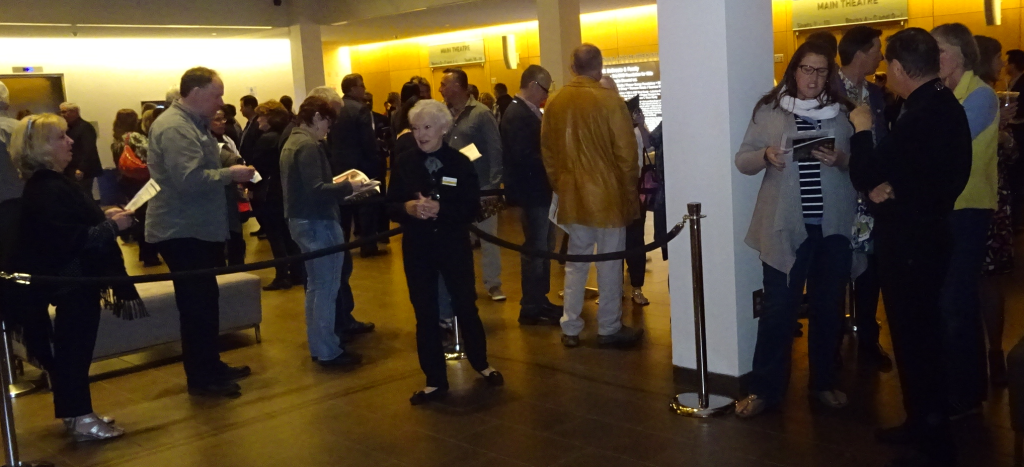 Patrons lined up to get their tickets booked. Performing Arts Centre president Suzanne Haines stood on one side of the stage and Director of Programming Costin Manu stood on the other side and read from telepromters. One would speak and then the other – as they passed the job back and forth.
There was an opportunity for the two of them to ham it up a bit and become part of the entertainment. At one point Costin was dancing away in small circles on his side of the stage – while Suzanne tapped her toes on the other. They could have danced towards each other and made their presentation much livelier.
Costin Manu can be very funny – he should have been given a writer to provide him with a bit of a script. It is after all show business.
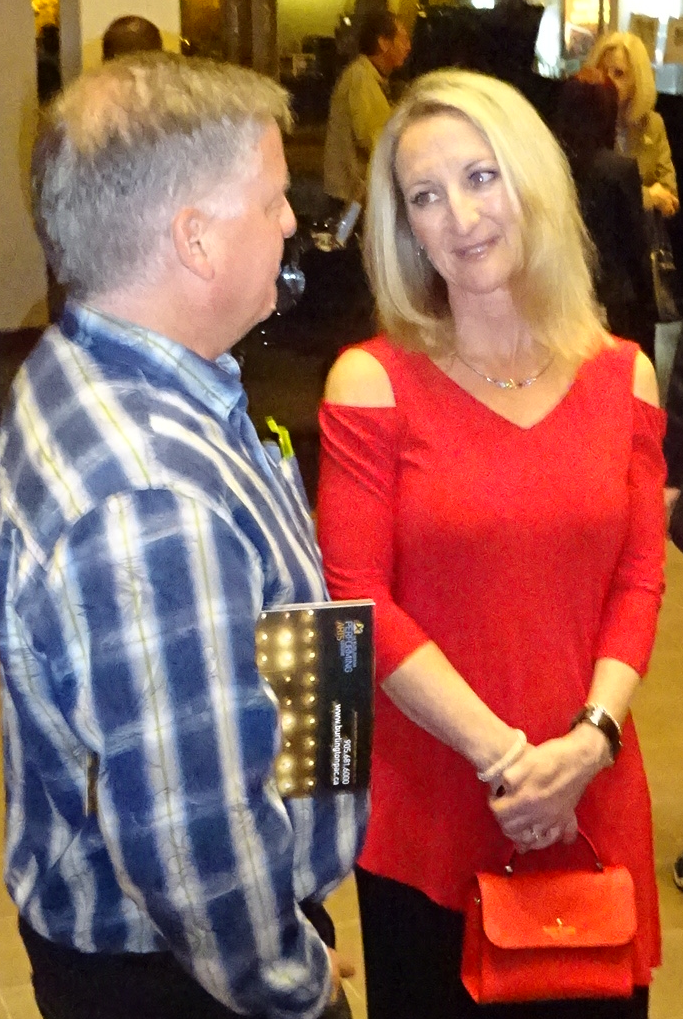 Ilene Elkaim, chair of the Theatre Board listens to a patron The “reveal” as many people chose to call the event closed with a nice touch. Haines announced that Royal Wood would return to the stage on October 1st – the 5th anniversary of the opening of the venue.
The Gazette was there that evening, which was described as a soft opening. The house wasn’t packed but the attendance was more than acceptable.
As Wood was taking his final bow two of what I describe as the “blue rinse” set strode up the aisle muttering about the lousy performance. They proved to be completely wrong – the place works – now to keep the costs in line and the content current, popular and just a little edgy at times.
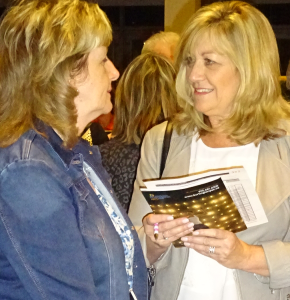 Deb Tymstra who reports on culture for Cogeco took in the evening and chats up a friend. The real test is to see the box office numbers – sales Tuesday night won’t be known until next week – they don’t appear to have adding machine over there.
 The Gazette will comment and report on the evening later in the week. It was a fun night, the finger food offering was plentiful – the wine offerings at the bar could do with some expansion. The program book patrons took away with them is a keeper – everything you want to know about the new season is within a well designed book. The Gazette will comment and report on the evening later in the week. It was a fun night, the finger food offering was plentiful – the wine offerings at the bar could do with some expansion. The program book patrons took away with them is a keeper – everything you want to know about the new season is within a well designed book.

 By Staff By Staff
May 17th, 2106
BURLINGTON, ON
The Regional Police have organized a very proactive approach to introducing how the police and emergency services work in the Region
On the 25th of May 2016, Halton Regional Police will be hosting ESINC Day (Emergency Service Introduction for New Canadians). The event will be held at the Halton Regional Police Service Headquarters located at 1151 Bronte Road, in the town of Oakville.
The event will run from 12:00pm to 2:00pm.
Come meet your local police officers, firefighters, paramedics, tour the emergency vehicles and visit the community information booths.
For more additional information please contact Cst. Jody Dugas of the Regional Community Mobilization Bureau. 905-825-4747 ext 5240.
If you know people who are new to Canada – mention this to them. Authority figures are seen differently in Canada than they are in the countries many new Canadians come from

 By Staff By Staff
May 17th, 2016
BURLINGTON, ON
The police are driving the message home: Canada Road Safety Week starts today
For the next seven days, until the end of the Victoria Day weekend, motorists who travel anywhere within the Region of Halton – from our urban centres to our rural areas – can expect to see an increased Police presence on our roadways.
How can you avoid being stopped by a Halton Police officer?
1. Drive now, call & text later. Distracted driving is one of the leading causes of motor vehicle collisions.
2. If you drink, don’t drive. Impaired driving remains the leading criminal cause of death on Ontario roadways. Halton Drug Recognition officers are also reminding drivers that drugs & driving don’t mix either.
3. If you’re under 22yrs of age, don’t drink & drive period. You must have a zero blood alcohol level to operate a motor vehicle in Ontario.
4. Buckle up. Over 700 Halton motorists were charged in 2015 with failing to wear a seat belt. What’s holding you back?
5. Slow down! Speed kills. Remember, we’ll see you before you see us. Speed limits will be enforced!
Motorists found in contravention may be subject to arrest and charges, including licence suspensions, vehicle seizures and costly fines. Halton Police encourages all road users to obey the rules of the road.
  Do your part and make our roadways safe for everyone. Do your part and make our roadways safe for everyone.
If you observe a vehicle being operated in a manner which places you, or anyone else in danger, please call 911 for an immediate police response.
Let us see what the police report after the holiday weekend.

 By Pepper Parr By Pepper Parr
May 16, 2016
BURLINGTON, ON
The Friends of Freeman station have to be nominated next year for one of the Burlington’s Best awards. This is without a doubt one of the best community organizations in the city. They fought hard to overcome serious inertia on the part of city hall and city council to save the Freeman Station.
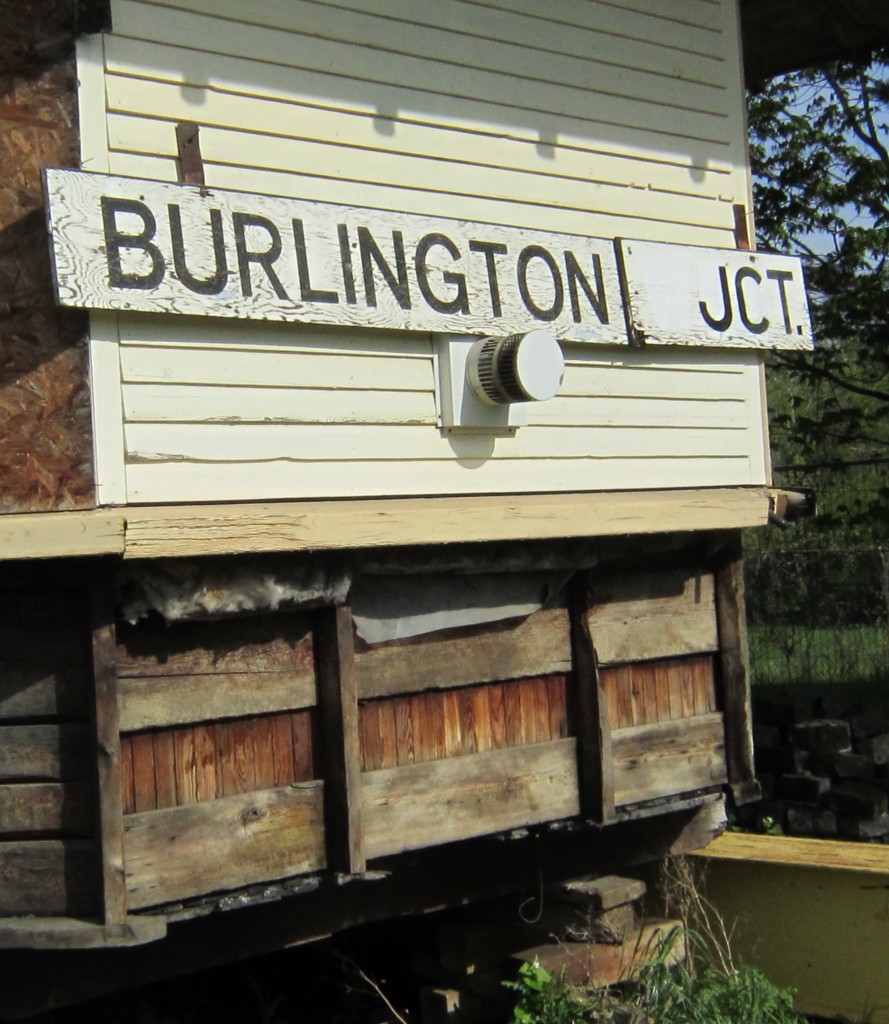 Sitting on some “cribbing” with a sign badly in need of several coats of paint, the Freeman Station gets ready for its big move. The city at one point had a very significant federal government grant to move and refurbish the station but couldn’t agree on where it should be located.
At one point the city ran an advertisement asking if anyone wanted the thing – to the best of our knowledge no one responded.
The late Jane Irwin fought hard to find a way to keep the structure that was in very sad shape sitting on cribbings beside the fire station on Fairview.
A city engineer actually told a Standing Committee that it couldn’t be save. That didn’t deter a group of die-hards who were not prepared to let the station get reduced to kindling.
 They had every reason to be smiling. Councillors Meed Ward and Lancaster pose with five members of the Friends of Freeman Station after the Council meeting that approved the entering into of a Joint Venture that would have the Friends moving the station and taking on the task of renovating the building. Councillors Marianne Meed Ward and Blair Lancaster who don’t agree on very much most of the time did come together and champion the Friends of Freeman Station. Now whenever there is a photo op the rest of council can’t line up fast enough to get their picture taken. Wait until the day the Station is officially opened – they will all be there with their best smiles painted on their faces.
But I digress – the Friends are going to be at Tansley Woods Community Centre, 1996 Itabashi Way, on Wednesday, June 1st – 9:30 – 4:00 to tell anyone who wants to listen about the station.
“Nostalgia… and fun!
— will be the order of the day when the Friends of Freeman Station travelling model railway exhibit is displayed at the Tansley Woods Community Centre in conjunction with the City of Burlington’s Parks and Recreation Department kickoff of Seniors’ Month — Wednesday, June 1st from 9:30 AM to 4 PM.
Nostalgia… “I remember travelling by train from the Burlington Junction Station…” Young-at-heart Burlington seniors recall fondly their experiences, as we re-create the era of steam power. You’ll see a model steam locomotive and passenger train, arriving and departing from a model of the the Burlington Junction Station just as it happened in the early Twentieth century. A beautifully crafted 1/24 scale model of the Station will be part of the display.
Fun! “Look, Grandma! It’s Thomas the Tank Engine!” Bring your grandchildren to see a rare demonstration of Thomas and friends Percy, Annie, Clarabell, Troublesome Truck #1, and Troublesome Truck #2 running on our scale model railway.
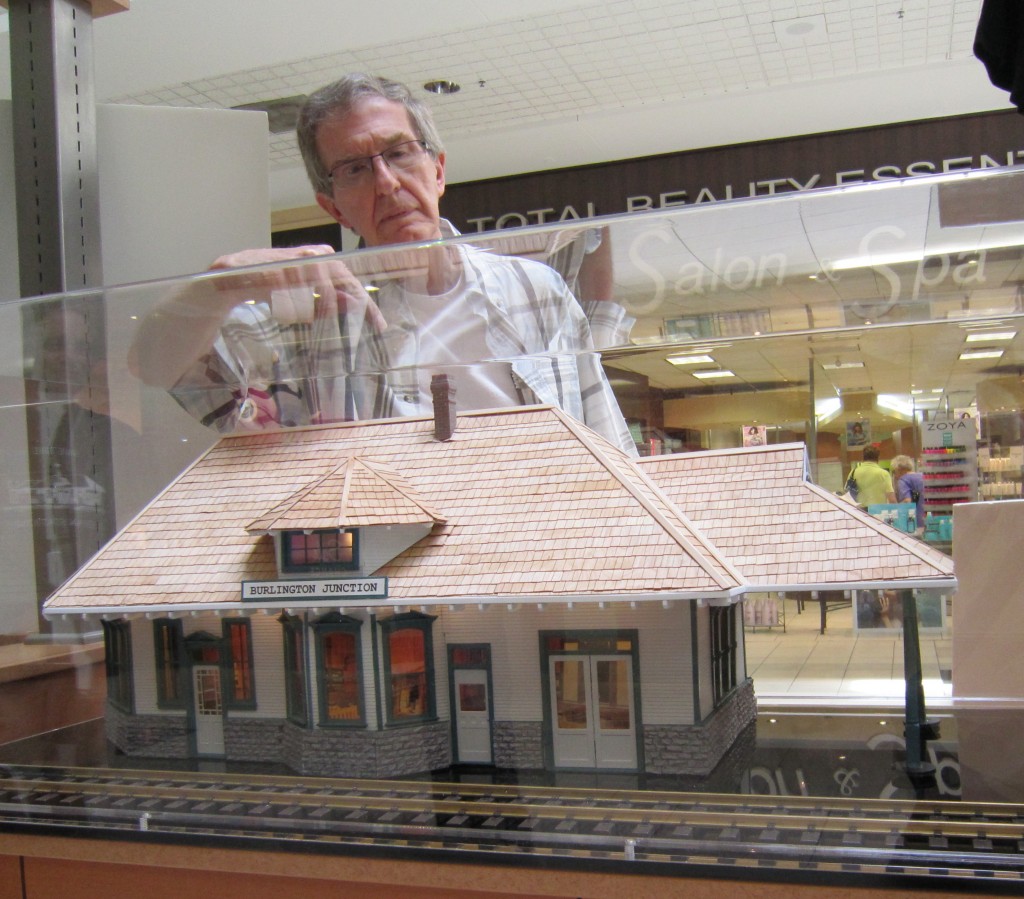 Bob Chambers points to a detail of the Freeman Station model he built in his kitchen in a short 41/2 months. The model will be on display at the Tansley Woods Community Centre. Tansley Woods Community Centre
We’ll be there… to share the amazing story of the relocation and restoration of Burlington’s 1906 Grand Trunk Railway Station, slated for completion in 2017. There, on the Lower Level, we’ll be constructing a historic model railway diorama depicting early Twentieth-century life in the hamlet of Freeman, now a part of Burlington.
This is one of the organizations that deserve whatever you can manage in the way of donations. Every dollar they get does into the refurbishing that are a a 100% volunteer organization –no one is paid – they rely entirely on private and corporate donations to fund the costs of restoring the Burlington Junction Station under an agreement with the City of Burlington.
They are superb at scrounging as well

 By Staff By Staff
May 16th, 2106
BURLINGTON, ON
We expect to use the picture frequently – it is a disturbing picture because if reflects an attitude towards the environment and the damage it is doing to the planet we live on.
 The crude decal is located inches above the exhaust pipe. Young people tend to flout conventional standards – but this standard is what is wrecking the weather system we have.
When we took the photograph the driver was parked in from of a shop with the engine idling while he chatted with the women in the car with him.
It was a nice car – there appears to be something about yellow in this city – see the link below.
One wonders what the parents think about the statement the young man chose to put on his “muscle car”
Related article.
What’s with yellow and this city?

 By Pepper Parr By Pepper Parr
May 15th, 2016
BURLINGTON, ON
There were few gifts in the weather this weekend.
Our Member of Parliament Karina Gould was scheduled to throw out the ceremonial pitch at a Burlington Bandits game – cancelled due to rain.
Hayley Marie Remple gave her Masters Class to flute players and then left town to begin her tour of western Canada. They are in for a treat.
 Monument marking the 3582nd kilometer of the Terry Fox Marathon of Hope Run that took place 35 years ago. The plaque noting that the historical Brant Inn used to be located a dozen yards or so to the south sits to the left of the monument.
There was an event that took place on a knoll on the north side of spencer smith Park where some history got cemented into place – not something Burlington has been all that good at doing.
A group of citizens thought it would be fitting for there to be a monument commemorating the day Terry Fox passed through Burlington on his Marathon of Hope 35 years ago.
The group that made this happen has chosen to be quiet – their concern was that the creation of the monument not take anything away from the annual Terry Fox run.
 The Brant Inn was located close to the edge of the lake – immediately south o the plaque – the Terry Fox monument sits on a bit of a knoll just west of the pond where small model motor boats will soon be scooting around. The monument is a very handsome structure.
It was originally going to be located closer to the intersection of |Lakeshore Road and Maple – some one came up with the idea of a more prominent location – right up beside the plaque that notes the existence of the Brant Inn – once a hot spot for American musicians who came to Burlington by train where they could play, sleep and eat in the same location.
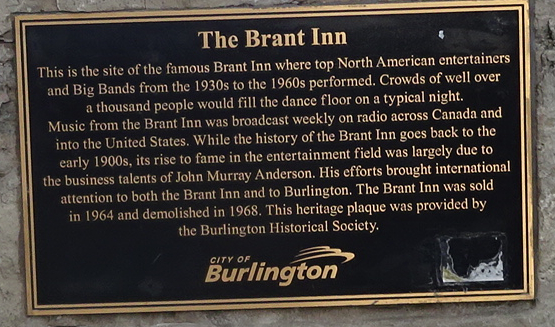 The plaque tells the story. It was the place to be in those days. Nothing like it in the city today. Pity The Brant Inn plaque is 15 to 20 yards from the site of the famous Inn. With the Fox monument steps away from the plaque – Burlington now has a spot where some significant history is commemorated. The Joseph Brant Museum is but a football field length to the west.
It will be interesting to see how the Tourism people feature the existence of the Fox monument in their literature and web site.
 Make a point of getting out to see it – it is both handsome and significant. Make a point of getting out to see it – it is both handsome and significant.
Good things can happen in Burlington.

 By Ray Rivers By Ray Rivers
May 13, 2016
BURLINGTON, ON
Even deep ecologists, the folks who’ll tell you that fire is a natural part of a sustainable forest, cannot defend what has been happening at Fort McMurray, Alberta. The ‘Beast’, Fort McMurray’s runaway fire is not a controlled burn by any measure. This has been called the worst environmental disaster in Canadian history.
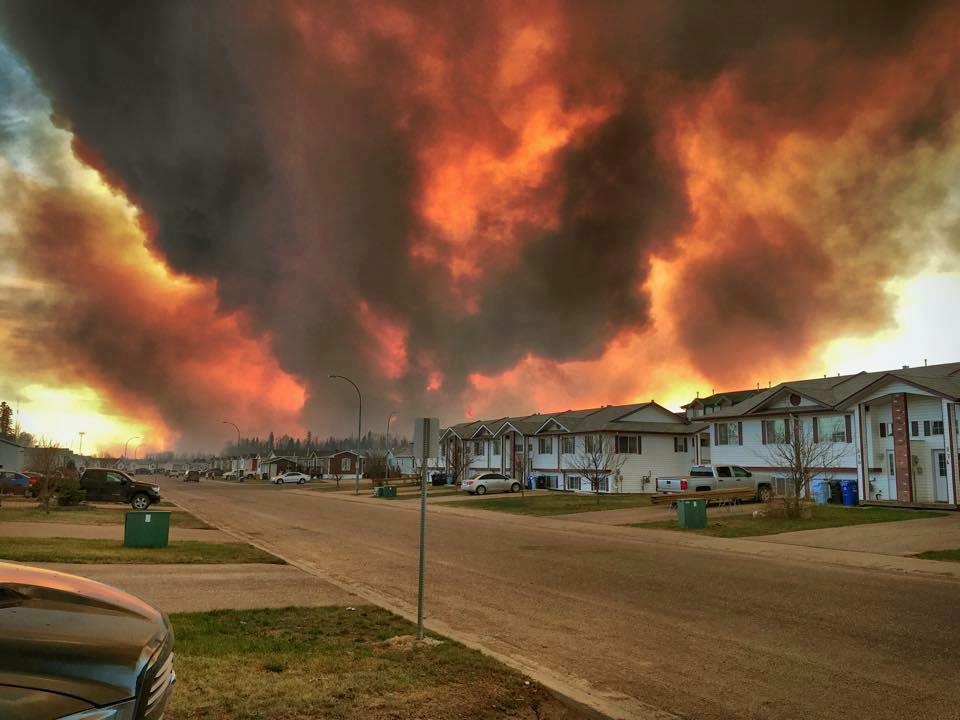 The fire, named the Beast bu he men and women who had to fight it day after day, moved into communities an wiped out everything in its path. The Beast has gobbled up over 200,000 hectares of woodland so far. That is more acreage than foresters harvest in B.C.annually. And it is twice as much as gets taken down each year in Ontario, generating 13 billion dollars in revenues, including some five billion dollars in forest products exports for our province. Also, Ontario’s treasury gets $100 million in royalty payments, and of course there are all those spin off benefits.
Firefighters managed to save an estimated eighty to ninety percent of the building stock in the Fort McMurray, though some suburbs were virtually destroyed. And the entire city and surrounding communities, as many as 100,000 residents, had to be evacuated. In a show of national unity all Canadians and many of their provincial governments came forward contributing fire-fighters and money to help with the consequences and aftermath of this event.
Canada is no stranger to forest fires. As a country which has the world’s second largest land mass, much of it sparsely populated, we typically lose over 600,000 hectares to fire every year. But the fire season has barely started this year and the Beast has already claimed a third of that with the fire still burning. The exceptionally hot and dry spring, and possibly a careless human, are the likely causes. But authorities worry that Edmonton, also experiencing exceptionally dry conditions, may be next.
Is climate change to blame? This is exactly the kind of event that climatologists have been predicting. And that would make this the second time in only a couple years, that Alberta has been hit with a major climate related event – recall that monster flood in Calgary a couple years ago. But few people are saying that in public. Well, Elizabeth May, the Green Party leader, is but then she’ll never be PM so she can say what is truly on her mind. Our new climate-change-fighting PM was reluctant to make the linkage, though he doesn’t really need to – it’s obvious.
Of course nobody wants to be accused of blaming the victims, including the oil sands operators who have had to suspend operations. Our hearts go out for the people who’ve lost their homes and possession, and have spent the last several days living in community centres, or with family somewhere else. And the truth is that leaping to shut down oil sands operations, in recognition of the reality before us, would hardly reverse the climate change we are experiencing in the short run anyway.
 The Leap Manifesto should at last be read – Rivers has created a link to the document at the bottom of his column. You may have heard about the Leap Manifesto, something which nearly tore the heart out of the recent NDP national convention in Edmonton. Avi Lewis, son of former Ontario NDP leader Stephen Lewis presented it in the faint hope of obtaining an endorsement by that party. Its non-partisan sticker notwithstanding, the document was produced to influence last year’s federal election and presumably energy policy in Alberta, though even Mr. Mulcair seemed to have mis-interpreted it and Alberta’s Premier was deadly opposed.
Lewis and his wife; journalist, author and social activist Naomi Klein, initiated this project as an afterthought to her book “This Changes Everything” and his documentary of the same name. A number of aboriginal leaders, other social and environmental activists, and wannabes assembled to write the Manifesto which reads, as one would expect, like something written by a committee.
Still Leap has morphed into something of a movement with over 40,000 signatures of support in its call to leap beyond business as usual this leap year, including the call for a guaranteed annual income for all Canadians. And as one of its primary targets, it has raised the hackles of the oil industry by its not so veiled call for shutting down the oil sands and any more pipeline construction.
Fort McMurray, Alberta’s oldest European settlement dating back to 1788, started out as a lonely fur trading establishment. Today it is known as the city that services Canada’s oil sands industry and Canada’s most valued export industry, despite the collapse of oil prices last year. The city will rebuild and recover, the forests surrounding it will regrow and things will go back to normal, for a while anyway.
But the message of the Leap Manifesto is right about how and where we ultimately need to get our energy. Forty years ago we didn’t speak of climate change or global warming. Fossil fuels seemed like the future, energy independence seemed critical and Canada was running out of oil.
 Alberta with the help of the federal government, then led by Mr. Trudeau’s father, supported the oil sands mega-project. But given what we know today, It may well take another Trudeau to help Albertans move away from producing the dirtiest oil on the planet. Alberta with the help of the federal government, then led by Mr. Trudeau’s father, supported the oil sands mega-project. But given what we know today, It may well take another Trudeau to help Albertans move away from producing the dirtiest oil on the planet.
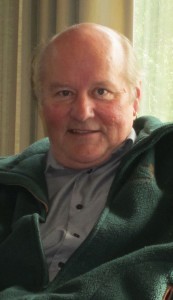
Ray Rivers writes weekly on both federal and provincial politics, applying his more than 25 years as a federal bureaucrat to his thinking. Rivers was a candidate for provincial office in Burlington where he ran as a Liberal against Cam Jackson in 1995, the year Mike Harris and the Common Sense Revolution swept the province. Rivers is no longer active with any political party.
Background links:
The Beast – Fire Damage – Climate Change – Oil Exports – Forest Facts –
Canada’s Forests – Carbon in Forests – Still Burning – Leap – This Changes Everything –
Mulcair on Leap –

 By Pepper Parr By Pepper Parr
May 12, 2016
BURLINGTON, ON
Governments are there to provide the services we need – one of which is to keep us healthy.
One of the ways we keep healthy is to immunize ourselves against diseases.
Some of the diseases we used to protect ourselves against have been eradicated because of the immunization programs. However, there are people who, usually through misinformation choose not to have their children vaccinated
The province is about to make it harder for people to not have themselves and their children vaccinated. If passed, and the government has a majority, it will become more difficult for parents to obtain exemptions for the now mandatory school vaccines and improve how these vaccines are reported.
The amendments to the Immunization of School Pupils Act would require parents and guardians who are considering not immunizing their children for non-medical reasons to participate in an education session delivered by their local public health unit. Parents or guardians would have to complete this session before obtaining a vaccine exemption.
 The Immunization of School Pupils Act would also be amended to require health care providers to report any vaccines they administer to children and youth—and that are needed to attend school in Ontario—to their local public health unit directly. The Immunization of School Pupils Act would also be amended to require health care providers to report any vaccines they administer to children and youth—and that are needed to attend school in Ontario—to their local public health unit directly.
Currently, parents are responsible for reporting their children’s immunization records, or “yellow card,” to their own local public health unit. This change, if passed, would make it easier for parents and reduce unnecessary suspensions due to out-of-date immunization records.
Strengthening the exemption and reporting requirements for school vaccines is part of Immunization 2020—Ontario’s five year strategy to improve its publicly-funded immunization program.
Perhaps strengthening the curriculum in high schools so that students understand the fundamentals of immunization and do not grow to become adults and not fully realize how we take care of ourselves from serious diseases.

 By Staff By Staff
May 12, 2106
BURLINGTON,ON
They are calling it road safety week – week – May 17-23, 2016. It is going to be a national campaign aimed at making Canada’s roads the safest in the world.
There were 1923 deaths due to accidents on roads in Canada in2013
 Multiple deaths on our highways – one in Ontario that killed every child in a family. The campaign is a police initiative designed to remind people that an essential part of the police enforcement role is to save lives and reduce injuries on our roadways. Educating the public about safe driving practices is a priority. The focus will be on behaviours that put drivers, passengers and other road users most at risk.
Referred to as the ‘Big 4 Killers’:
impaired operation by alcohol or drug,
seat belt use
all aspects related to aggressive
and distracted driving.
Police agencies across the country are collaborating on this initiative and asking you to choose safe behaviours while travelling on our roadways, whether you are a driver or a passenger. We need to work together to ensure that Canada’s roadways are the safest in the world.
 There is just no excuse for this kind of behaviour – the penalties are to light. Impound th car and arrest the driver. During the first five months of 2016, eight motorists or passengers have died on Regional roadways along with seven others sustaining life altering injuries. These collisions result in extremely tragic circumstances which highlight the fact that preventable driving behaviors cause of too many collisions. Driving behavior impacts the safety of our community, can result in tragic outcomes and serious repercussions.
- In 2013, the number of motor vehicle fatalities was 1,923; down 7.4% from 2012 (2,076).
- The downward trend for serious injuries continued, dropping to 10,315 in 2013; down 7.2% from 2012 (11,116).
- The rate of the number of fatalities per 100,000 population was 5 in 2013, down from 6.0 in 2012.
- 2013 marked the first time that the fatality rate per 10,000 registered vehicles (of 0.83) was below 9.
 The Halton Regional Police Service enforces all matters of road safety 24 hours per day, 7 days a week. In support of Canada Road Safety Week, the Halton Police will adapt a heightened level of presence on our roadways, looking for impaired and distracted motorists, along with those who choose to speed or not wear a seatbelt. The Halton Regional Police Service enforces all matters of road safety 24 hours per day, 7 days a week. In support of Canada Road Safety Week, the Halton Police will adapt a heightened level of presence on our roadways, looking for impaired and distracted motorists, along with those who choose to speed or not wear a seatbelt.
Motorists found in contravention may be subject to arrest & charges, including licence suspensions, vehicle seizures and costly fines.
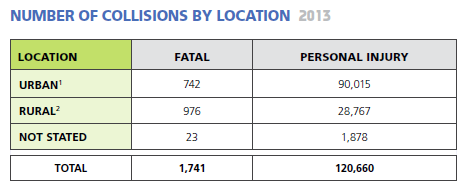 If you observe a vehicle being operated in a manner which places you, or anyone else in danger, please call 911 for an immediate police response. Halton residents are also encouraged to report any criminal activity to Crime Stoppers at 1 800 222-8477 (TIPS) or through the web at www.haltoncrimestoppers.com or by texting “Tip201” with your message to 274637 (crimes). If you observe a vehicle being operated in a manner which places you, or anyone else in danger, please call 911 for an immediate police response. Halton residents are also encouraged to report any criminal activity to Crime Stoppers at 1 800 222-8477 (TIPS) or through the web at www.haltoncrimestoppers.com or by texting “Tip201” with your message to 274637 (crimes).

 By Staff By Staff
May 11th, 2016
BURLINGTON, ON
Our colleagues at CATCH (Citizens at City Hall) published a piece on a meeting where the provincial Minister of the Environment and Climate Change spoke of the impact climate change is having on us – Now. Burlington understands what he is talking about – he drives the point even further than the August 2014 flood did,
Ontario’s minister of the environment and climate change had some blunt advice when he spoke at the climate resilient cities conference in Hamilton recently. Glenn Murray offered detailed evidence that climate change already threatens our food and water security and it’s going to get much worse.
While he declared that “there’s nothing that Hamilton lacks to be the kick-ass city in Canada”, the former mayor of Winnipeg made clear that “fundamental transformation” in our urban form is required including intensification and no more suburban sprawl.
“I want to take you to the context of where I think we as a group of leaders have to understand and what the dynamics are,” he began. “And I will just offer the proposition that the two biggest crises that we face on the adaptation and resilience side are food security and water security.”
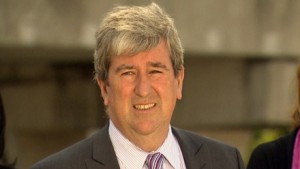 Glen Murray – Minister of the Environment and Climate Change He pointed to a Toronto storm three years ago that dumped a month’s rain in one hour and tore out 80 metres of GO train track “that cost us $600 million which could basically pay for half of [Hamilton’s] LRT.” And he cited “false springs” that wiped out the local apple crop in 2012. He also explained the link of many extreme weather events to the melting arctic ice cap and its effect on the polar vortex.
“The jet stream has slowed down by about 20 percent which means that the periods which are wet last longer, the periods which are dry last longer and that causes us to have so many droughts as we saw in the prairies, fires, invasions of species – the beetles that are destroying our forests,” Minister Murray explained. “And then we have moisture levels on the prairies that we haven’t seen since the last ice age – and if we didn’t have the modern irrigation we have now we probably would be courting if not in the dust bowl, and for the first time Calgary and Regina had air quality warnings because of the level of smoke from fires on the prairies.”
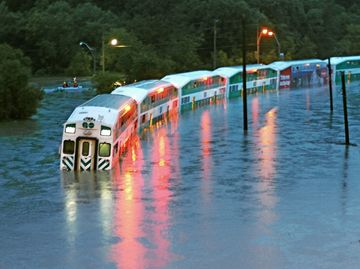 The cost of repairing GO train tracks when Toronto experienced flooding would have paid for half of the LRT coming to Hamilton. He spoke a week before a tinder dry forest and 32C temperatures helped fuel the catastrophic fire in Fort McMurray despite its near sub-arctic location at the same latitude as the northern tip of Ontario and lower Hudson’s Bay.
Murray reminded his audience that last year’s “disruptive spring” experiences included four to five metres of snow “on the streets of Halifax and St John’s” in the last week of April and asked what that would have done in Hamilton. “No one had much of a garden in Atlantic Canada last year. That was also the summer that we had fires on the Prairies the soft fruit crop blossomed in January in BC and died.”
Focusing particularly on food security, the Minister argued that the jet stream destabilization has “had some very bad impacts on our ability to produce food” and warned that “if you want to destabilize a government, all you have to do as a society is just have a food or water shortage for any period of time.”
As an example, he pointed to the extreme drought in the Middle East in 2006-2011 where there was “an 80 percent food crop loss in northern Syria and the fertile crescent about 1.6 million people lost their farms and became the underclass in Damascas, which was according to the Pentagon a swift threat multiplier in the destabilization of the region and the on-going war and then the insertion of terrorism.” Murray noted that “ISIS is hanging onto the three largest irrigation dams … so they’re obviously sophisticated in assessing the power of control of water.”
 Fields of California broccoli – 95% of ours comes from here. Bringing this closer to home, the Minister detailed the development of the California drought where “80 percent of water use is for agriculture” and the National Oceanic and Atmospheric Administration (NOAA) has found the description of extreme drought no longer adequate and has introduced “exceptional drought” into its terminology.
“You see the blood red stain in the middle of California ,” he said pointing to one of his slides. “That’s a piece of real estate that’s very important to your life and to my life because we import $4 billion worth of food as a northern community.”
California, he explained, provides “95 percent of all US broccoli, 92 percent of strawberries, 91% of grapes, 90 percent of tomatoes, 84 percent of all lettuce” and similar percentages to Ontario. While noting that almost all of this is grown in that blood red stained area, Murray warned he “could keep going with all the other things your mother told you to eat lots of when you were growing up.”
A particular “perversity” in the California situation is that nut and pistachio growers are “have now bought surplus drilling equipment from Alberta” and are “going down 2000 feet into the aquifers of California leading to collapse, whereas the vegetable farmers can only afford equipment that goes down about 200 feet.”
 Burlington resident weren’t comfortable with a five storey project in the downtown core – developer cut it back to four. This is an absurdity,” Murray declared. Murray also explained that the climate change we’re already seeing is certain to get significantly worse because carbon dioxide stays in the atmosphere for 40 to 250 years.
“So looking back right now we are experiencing the full force of carbon dioxide levels from 1916, in the middle of the First World War, and we’re just now experiencing the initial impacts of carbon dioxide from 1976 when I graduated from high school.”
He underlined that “sobering” thought by noting that “the rapid explosion of the suburbs in the fifties – the great low density carbon intensive neighbourhoods – all the weight of all of that activity and change in urban form has not yet impacted.”
 Burlington Hydro loaned electric BMW’s to city council members top record their driving habits – when will the wave of buying electric cars hit us? Murray connected this to the province’s commitment to rapid transit by inviting the audience to look at the Yonge subway line in Toronto from the vantage point of the top of the CN tower. “You can clearly see where it is because at every subway stop there are spikes of large commercial and residential buildings all the way up to York,” he said.
He compared that to the Bloor line where city councillors and their residents fight intensification. “There’s a fight over a four-storey building in Etobicoke – they’re fighting it because it’s ‘too intense’. This is the absurdity,” Murray declared.
He didn’t suggest this might happen along Hamilton’s LRT line, but the link was obvious, and he underlined it by the results of a mapping study of taxes versus density that confirmed “all the neighbourhoods who use a lot of infrastructure for a very small tax base are well dispersed suburbs, big box formula subdivisions, and Hamilton.”
He ended with advice to individual Hamiltonians: “Drive less, get an electric vehicle, congratulations on getting a rapid transit line in Hamilton and please use it. Or walk, it’s a beautiful city to walk in.”

 By Staff By Staff
May 10th, 2016
BURLINGTON, ON
Hayley Marie Remple is on the road – last concert tour before I get hitched” was the way she put the trip that is going to bring her to Burlington for a two concert program and a Master Class for flute players.
 Hailey Marie mixes narrative with visual presentation and the smooth sound of her flute as she tells the story of the composers who basically shaped much of the classical music we have today. Hailey Marie mixes narrative with visual presentation and the smooth sound of her flute as she tells the story of the composers who basically shaped much of the classical music we have today.
A graduate of both McGill and Yale – she has played on the stage of Carnegie Hall on two occasions – no small feat. Speaking of feet – she apparently plays barefoot.
This artist is on a five province tour – returns to Winnipeg for her nuptials.
Hayley Marie is a romantic who sees music as a way to tell a story – the sound if of course critical – but this isn’t a lady who stands up – plays and then sits down.
She talks and will tell you far more than you ever thought you wanted to know about some of the great composers.
May 12th at the Performing Arts Centre. 7:30 pm
This artist will play the work of Debussy, Ravel, Saint Saens,Faure, Wido rand Satie who were composing during the period Hayley Marie focuses on.
She has researched both the time frame she has chosen to focus on and the lives of the composers and tells the people who follow her all kinds of delightful gossip that she calls her Two Minute Talks
A Hayley Marie Remple Two Minute Talk
Previous articles:
An Evening in Paris
Someone is going to go to Paris

 By Pepper Parr By Pepper Parr
May 10th, 2016
BURLINGTON, ON
Well – it is official – with more people than is usually required to get a car out of a ditch, the $500,000 parking meter system went into use officially on Monday.
 Looks like half of the Transportation department + a good portion of the city’s communications team was needed to launch the new parking meters. It took three different Requests for Proposals to get this project to the finish line. Luigi Lato , Chief Operating Officer, Precise ParkLink said he was honoured to attend the ribbon cutting ceremony, expressing that he is “overjoyed with the city’s excitement to introduce Precise ParkLink’s Pay-By-Plate parking technology. The residents will enjoy the upgraded parking system which brings Burlington on par with other global cities that use the Parkeon Pay-By-Plate parking meters and TelePark Pay-By-Cell option”.
So much for that!
The system is being paid for with funds that were in a reserve fund that is the levy the city places on commercial establishments in the downtown core. Ward 2 Councillor Marianne Meed Ward explained that the taxpayers were not the people paying for the system.
The difference for regular parking is – making sure you remember the license number of the car you are parking.
You can use cash or credit card. You will also be able to use your cell phone to pay for your parking. Referred to as TelePark, it is a service that you have to register for – something you do one line. W will explain this in more detail in a follow up article.
During the launch ceremonies IT staff did say there were some hiccup getting the back end of the system to work – it has to interact with the credit card organizations on a network that has the highest possible security.
 Expect to see people with PAYBYPL8 walking the downtown core looking for perplexed citizens wanting to pay for their parking. They are Parking Ambassadors – there to help! The city will go into a full court press media mode explaining how the system works and will have people on the street – they are being called “Parking Ambassadors” walking around the downtown core to answer questions.
 An additional feature is the ability of commercial operations to pay for the parking of their customers should they choose to do so. The take up on that opportunity doesn’t look all that promising at this point but as Mary Shepherd explained “these things take time for people to understand and then implement.” An additional feature is the ability of commercial operations to pay for the parking of their customers should they choose to do so. The take up on that opportunity doesn’t look all that promising at this point but as Mary Shepherd explained “these things take time for people to understand and then implement.”
 Ward 2 Councillor Marianne Meed Ward handling the cash part of the old parking meter with Downtown Business Association president Brian Dean. He is the one who is going to have to herd his members into taking on the feature that will let his members pay for client parking. Good luck Brian. The public hasn’t been jumping for joy. Michael Jones points out that these machines are in Hamilton and are not very user friendly – also if you have leftover time on your ticket you can’t share that with anyone. He adds: “ say goodbye to the great feeling of pulling up and seeing 20 minutes left on the previous parker’s meter …felt like winning a mini lottery”.
Some of the posts that held the old parking meters are being re-purposed and will become bicycle racks.

 By Staff By Staff
May 9th, 2016
BURLINGTON, ON
Halton District School Board’s annual Inside and Out Conference will take place on Tuesday, May 17, 2016 at Country Heritage Park, 8560 Tremaine Rd., Milton.
Registration will begin at 9:30 a.m., with the conference concluding at 2 p.m.
 The Regional police have been very supportive and proactive in the way they work with the LGBT community. It’s the rest of the community that has to get onside. The conference, titled, Inside and Out – What Are Your Colours? is in partnership with the Canadian Centre for Gender and Sexual Diversity and the Positive Space Network of Halton. These organizations work to eliminate bullying, homophobia, transphobia, and other forms of discrimination in schools and youth communities.
The goal of the all-day conference is to provide a forum for students and staff, through various workshops, to discuss how they can make their schools more welcoming and inclusive for lesbian, gay, bisexual, transgender, intersex and two spirit individuals.
The conference will also celebrate equity and diversity in the Halton District School Board. It is being organized by the Safe and Inclusive Schools Team and staff and students at Acton High School and McKenzie-Smith Bennett Public School, including their Gay Straight Alliance (GSA) groups.
The conference will open with guest speaker MPP Cheri DiNovo, who is an activist for the LGBTQ community, particularly transgender people. The conference will close with a slam poetry performance by Jenna Tenn-Yuk. There will also be a reading by Nik Kaur-Singh and closing comments by Sam Lambert, both former Halton District School Board students and LGBTQ+ rights advocates.
A number of community agencies will be attending the conference including Halton Public Health, SAVIS, Positive Space Network, Youth Action Committee, EGALE Canada and New Directions Ministries.
The meeting is open to anyone wishing to attend

 By Pepper Parr By Pepper Parr
May 5, 2016
BURLINGTON, ON
She was born and bred in Lowville – the strongest part of her support network is the five girlfriends she worked with at Emmas – at times she moves from place to place with an armed escort.
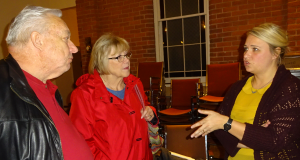 Lindsay Hawkin talking to a couple that wanted to know about the gifts of chickens and goats to refugees. Lindsay Hawkin works for World Vision – she is a project manager – responsible for the delivery of programs to refugees in some of the most dangerous places in the world.
Lindsay, who works and lives among Syrian Refugees was home for as short break and talking to people at the Lowville United Church about her experiences while living in refugee camps as a worker.
Lindsay has been “in the field” for the past seven years, mostly with World Vision but at times with other organizations.
The work that gives her the most satisfaction is when she is working with children and woman. She takes great satisfaction from a clinic that was opened and staffed by women that had a psychological counselling service for women who were victims of sexual abuse – something that is prevalent in the countries she works in.
Lindsay has a degree in political science and a Master’s degree in International Relations. For a period of time she worked for the Canadian government at the embassy in Washington.
She has a strong grasp of both the world wide refugee picture and a solid understanding of what happens day to day in refugee camps with populations of 22,000 plus people.
For much of the time she lives in a shipping container – made of plastic. The containers cost between $2000 and $3000 and are air conditioned.
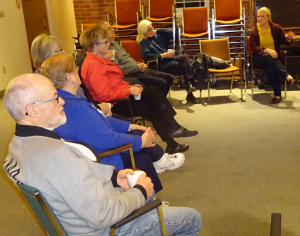 Members of the Lowville and Nelson United Churches listen to Lindsay Hawkin as tells of her work in Middle Eastern refugee camps. Lindsay told the small group she was talking to that at the end of December 250,000 people had been killed in Syria, 4.8 million people had to flee the country and 13.5 million people needed some form of humanitarian assistance.
In a country where kidnapping is rampant – three of her staff were taken – and recovered. The hospitals her people work in were bombed
She told the small audience – made up mostly of people from the Lowville and Nelson United churches who were involved with the sponsorship of refugees – that the risk factor may appear high – but if we are careful – we are safe.
Non governmental organizations (NGO’s) strive to create relationships with the people they serve. We are never armed, we do not take sides – our job is to help people who need help. To look for ways to add something to the lives they lives.
“I know why I am here” said Lindsay “to make a difference.”
 Zaatari Refugee Camp – Jordan Working in the Middle East is a personal choice, she said. “I don’t always know why I make the choices I do but I am comfortable with the decisions I make.” “My work in the Middle East started with a travel bug – I just wanted to see more of the world” – she now works in some of the most dangerous places.
Burn out, depression and PTSD are part of the work that Lindsay does. Some people turn to alcohol or drugs to handle the difficulty they are having. But that is a “rabbit hole” and there is nothing there for you down that hole. “I have been fortunate in that I have strong relationships that support me in the work I do. My five girl friends are a life line – even though I don’t see them very often,
We are called the visibles by the people we serve. That is because we are white and to them we are visible.
The delight Lindsay takes in the work she does comes through in the stories she tells. “We were in Mogadishu on an ocean beach and I wanted to go swimming. One of the woman told me she had never gone swimming so we both waded into the water – her full clothed because women in the Middle East do not expose their bodies. I held her hands and pulled her through the water while she laughed and laughed.
There isn’t much for these people to laugh about added Lindsay
Lindsay met the man she is now married to in Afghanistan. He is a Brit, works as a contract bomb disposal technician. “He is pretty dreamy” she said.
Asked what does she does the moment she is back in Canada. I ask my brother who often picks me up at the airport to buy me a hamburger.

|
|
 By Staff
By Staff




















































 The Immunization of School Pupils Act would also be amended to require health care providers to report any vaccines they administer to children and youth—and that are needed to attend school in Ontario—to their local public health unit directly.
The Immunization of School Pupils Act would also be amended to require health care providers to report any vaccines they administer to children and youth—and that are needed to attend school in Ontario—to their local public health unit directly.

 The Halton Regional Police Service enforces all matters of road safety 24 hours per day, 7 days a week. In support of Canada Road Safety Week, the Halton Police will adapt a heightened level of presence on our roadways, looking for impaired and distracted motorists, along with those who choose to speed or not wear a seatbelt.
The Halton Regional Police Service enforces all matters of road safety 24 hours per day, 7 days a week. In support of Canada Road Safety Week, the Halton Police will adapt a heightened level of presence on our roadways, looking for impaired and distracted motorists, along with those who choose to speed or not wear a seatbelt. If you observe a vehicle being operated in a manner which places you, or anyone else in danger, please call 911 for an immediate police response. Halton residents are also encouraged to report any criminal activity to Crime Stoppers at 1 800 222-8477 (TIPS) or through the web at www.haltoncrimestoppers.com or by texting “Tip201” with your message to 274637 (crimes).
If you observe a vehicle being operated in a manner which places you, or anyone else in danger, please call 911 for an immediate police response. Halton residents are also encouraged to report any criminal activity to Crime Stoppers at 1 800 222-8477 (TIPS) or through the web at www.haltoncrimestoppers.com or by texting “Tip201” with your message to 274637 (crimes).




 Hailey Marie mixes narrative with visual presentation and the smooth sound of her flute as she tells the story of the composers who basically shaped much of the classical music we have today.
Hailey Marie mixes narrative with visual presentation and the smooth sound of her flute as she tells the story of the composers who basically shaped much of the classical music we have today.










